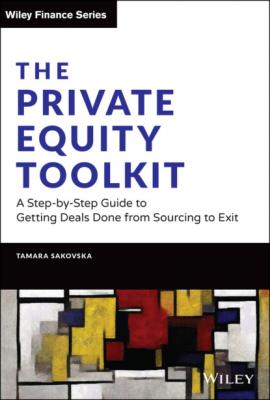The Private Equity Toolkit. Tamara Sakovska
Читать онлайн.| Название | The Private Equity Toolkit |
|---|---|
| Автор произведения | Tamara Sakovska |
| Жанр | Ценные бумаги, инвестиции |
| Серия | |
| Издательство | Ценные бумаги, инвестиции |
| Год выпуска | 0 |
| isbn | 9781119697114 |
The four most common sources of competitive advantage for any business
Forget the detail: just a few key financial metrics that matter for deal selection
How clever structuring can help you overcome valuation concerns
Chapter 6: Assessing the Top Management Team
Key Topics:
Why motivating superb managers is the key ingredient in private equity's secret sauce
Why the best CEOs are not the charismatic and articulate leaders we see in movies
What makes the job of a private equity CEO among the most demanding in the world
Nine key qualities to look out for when assessing CEOs for private equity businesses
How you can apply the latest best practices in your assessment of management teams
Chapter 7: Analyzing the Business Plan
Key Topics:
Why skilled investors explore business fundamentals before diving into the numbers
Key problem areas to spot immediately in every business plan you review
How to poke holes in overoptimistic projections and make your investment case add up
Ten cold, hard questions that every solid business plan needs to address
My trusted business plan tool: Master List of Most Common Drivers of Value Creation
Chapter 8: Valuation
Key Topics:
Enterprise value, headline price and cash consideration: why they are each different
How experienced investors use flawed valuation methods and still get to the right answer
Seven valuation metrics and six valuation methods I like (and hate) to use
Two valuation approaches for those times when you find “difficult to value” companies
You've done the valuation: How much will you pay to win the deal?
Chapter 9: Deal Structuring
Key Topics:
Capital structure considerations: what type of leverage to use and when it is too much
Management Incentive Plans: target A, reward A and achieve A
Enhance your deal through earn-outs, earn-ins, escrows and vendor loan notes
Minority deals: negotiate robust exit rights or be held hostage by majority owners
Advanced deal structuring techniques for minority investments
Chapter 10: Deal Execution: Transaction Process and Due Diligence
Key Topics:
What to expect in a typical private equity transaction process
Don't “boil the ocean”: ten principles of a well-managed due diligence effort
Who does what and why you need it: an anatomy of the key due diligence workstreams
Chapter 11: Deal Execution: Legal Documentation
Key Topics:
Why you don't need to be a lawyer to provide valuable input in legal negotiations
How to translate due diligence findings into legal clauses in the deal documentation
My cheat sheet summary of common issues in the key transaction agreements
Chapter 12: Adding Value Through Active Ownership
Key Topics:
Develop your own success formula with a Value Creation Plan
Four value-accretive actions for every portfolio company to consider
Create powerful performance improvement momentum with a 100-Day Plan
Governance and reporting: strategic priorities of a well-run private equity board
When things go wrong: spot the first signs of company distress and take radical action
Chapter 13: Exit Strategies and Deal Monetization
Key Topics:
How to exit a minority investment (effortlessly)
Exiting a majority transaction: Should you time the market?
Conventional exit routes: an IPO, strategic sale or sponsor-to-sponsor buyout
Can't exit your investment? Alternative deal monetization strategies to the rescue
The finishing touch: exit preparation roadmap for every portfolio company
Acknowledgments
I owe a debt of gratitude to my family, who supported me throughout my book-writing journey and helped bring this project to fruition. A warm thank-you to my wonderful husband Frederik, who was the first reader of every chapter in the book (not always entirely by choice). I would also like to acknowledge the invaluable support of my children, August and Daria. Thank you for coming with me to my office during numerous weekends and inspiring me to persevere during challenging times. I also would like to thank my sister Julia, my parents and grandparents for instilling me with a strong work ethic and teaching me the importance of critical thinking.
I am fortunate to have an extraordinary group of friends, many of whom encouraged me to write this book and provided constructive comments on my manuscript: thank you, Stefan Loesch, Oksana Denysenko, Helena Clavel-Flores, Irina Grigorenko, Vittoria Stefanello, Leopoldo Carbone, Julia Shur and Oksana Tiedt. In addition, I am grateful to Lee Barbour for delivering first-class editing support, and to Emma Stefanello and Michael Majdalani for providing excellent research assistance.
I would like to express my gratitude to Eli Talmor, Dirk Donath, Giampiero Mazza, Joshua Rosenbaum, Joshua Pearl, Alex Emery and Ted Berk. Each of these highly accomplished individuals were kind enough to read my book and provide me with their personal endorsement.
A special thanks to everyone in the Wiley team who assisted me in making this book a reality: my acquisitions editor, Bill Falloon, my assistant acquisitions editor, Samantha Enders, my managing editor, Purvi Patel, and my Editorial Assistant, Samantha Wu.
Finally, I would like to say thank you to a long list of brilliant work colleagues who taught me everything I know about private equity and dedicated their time to developing my investment acumen early in my career. I can't name you all, but you probably remember the long hours we worked together and know who you are, folks. Thank you!
About the Author
Tamara Sakovska is a private equity investor, board director and the founder of Lavra Group. She has over two decades of finance and
